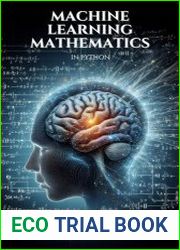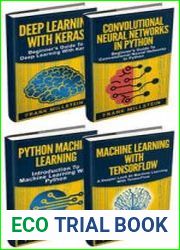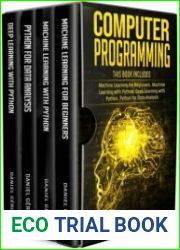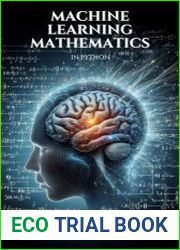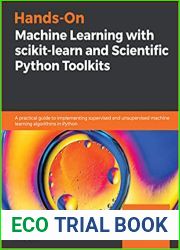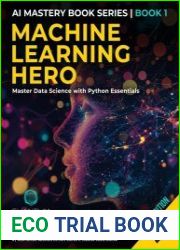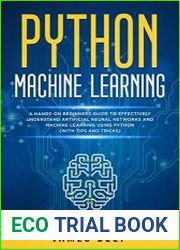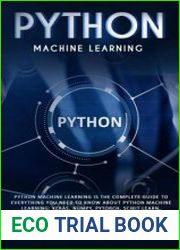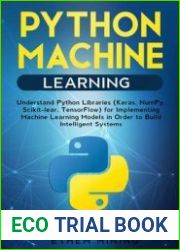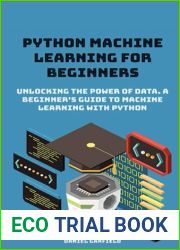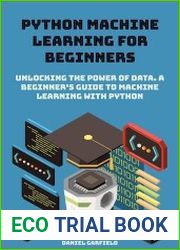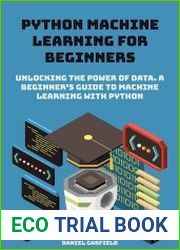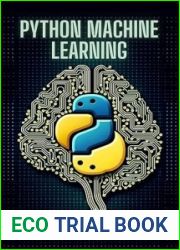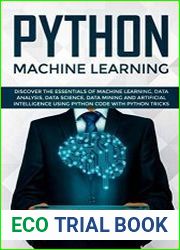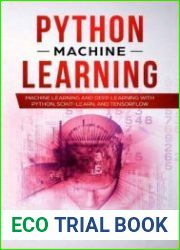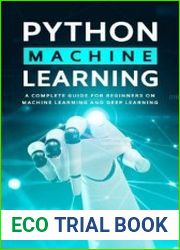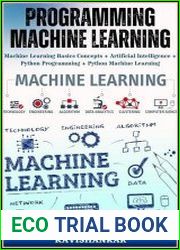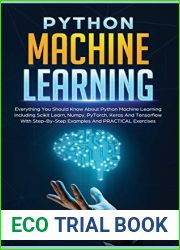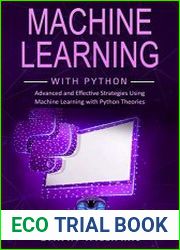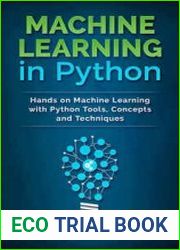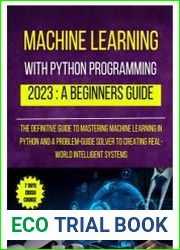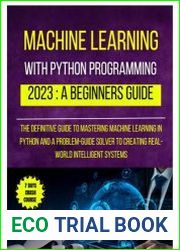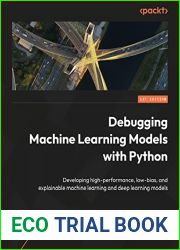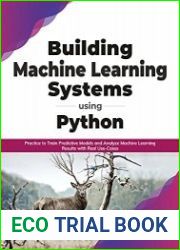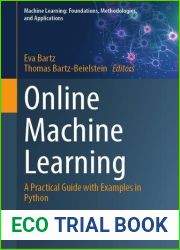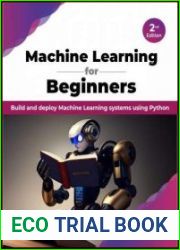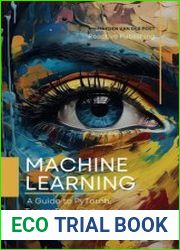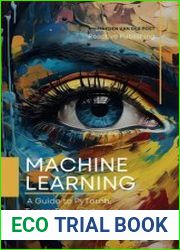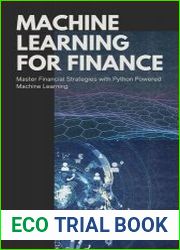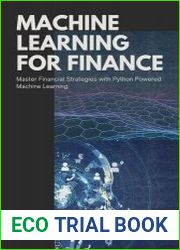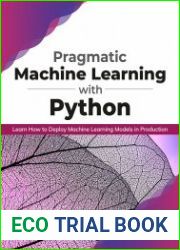
BOOKS - Machine Learning Mathematics in Python

Machine Learning Mathematics in Python
Author: Jamie Flux
Year: 2024
Pages: 238
Format: PDF
File size: 10.1 MB
Language: ENG

Year: 2024
Pages: 238
Format: PDF
File size: 10.1 MB
Language: ENG

The book "Machine Learning Mathematics in Python" is a comprehensive guide to understanding the mathematical foundations of machine learning algorithms using Python programming language. The book covers various topics such as linear algebra, calculus, probability, and statistics, which are essential for building intelligent systems. It provides a detailed explanation of the concepts and techniques used in machine learning, making it easier for readers to grasp the subject matter. The book begins by introducing the reader to the basics of machine learning and its importance in today's world. It highlights the growing demand for skilled professionals who can develop and apply machine learning algorithms to solve real-world problems. The author emphasizes the need to understand the underlying mathematics of machine learning to create more accurate and efficient models. The book then delves into the fundamental concepts of linear algebra, including vector spaces, matrices, and tensor operations. It explains how these concepts are crucial for developing machine learning algorithms that can handle large datasets and perform complex tasks. The author also discusses the importance of eigendecomposition and singular value decomposition, which are critical in reducing the dimensionality of data and improving model performance. Next, the book explores the concept of gradient descent and its role in optimizing machine learning models. It explains how gradient descent works and how it can be used to minimize the loss function in a neural network. The author also discusses the different optimization algorithms available in Python, such as stochastic gradient descent and Adam, and their applications in various scenarios. The book also covers probability theory, which is essential for understanding the uncertainty of machine learning models. It explains the concept of probability distributions, Bayes' theorem, and Markov chains, providing readers with a solid foundation in probability theory. Additionally, the book discusses statistical techniques such as hypothesis testing and regression analysis, which are vital in machine learning.
Книга «Математика машинного обучения в Python» представляет собой всеобъемлющее руководство по пониманию математических основ алгоритмов машинного обучения с использованием языка программирования Python. Книга охватывает различные темы, такие как линейная алгебра, исчисление, вероятность и статистика, которые имеют важное значение для построения интеллектуальных систем. Он предоставляет подробное объяснение концепций и методов, используемых в машинном обучении, облегчая читателям понимание предмета. Книга начинается с знакомства читателя с основами машинного обучения и его важностью в современном мире. В нем подчеркивается растущий спрос на квалифицированных специалистов, способных разрабатывать и применять алгоритмы машинного обучения для решения реальных задач. Автор подчеркивает необходимость понимания лежащей в основе математики машинного обучения для создания более точных и эффективных моделей. Затем книга углубляется в фундаментальные понятия линейной алгебры, включая векторные пространства, матрицы и тензорные операции. В нем объясняется, как эти концепции имеют решающее значение для разработки алгоритмов машинного обучения, которые могут обрабатывать большие наборы данных и выполнять сложные задачи. Автор также обсуждает важность собственного разложения и разложения по сингулярным значениям, которые имеют решающее значение для уменьшения размерности данных и повышения производительности модели. Далее в книге исследуется концепция градиентного спуска и его роль в оптимизации моделей машинного обучения. В ней объясняется, как работает градиентный спуск и как его можно использовать для минимизации функции потерь в нейронной сети. Автор также обсуждает различные алгоритмы оптимизации, доступные в Python, такие как стохастический градиентный спуск и Adam, и их применения в различных сценариях. Книга также охватывает теорию вероятностей, которая необходима для понимания неопределенности моделей машинного обучения. Она объясняет концепцию вероятностных распределений, теорему Байеса и цепи Маркова, предоставляя читателям прочную основу в теории вероятностей. Кроме того, в книге обсуждаются статистические методы, такие как проверка гипотез и регрессионный анализ, которые жизненно важны для машинного обучения.
livre « Mathématiques de l'apprentissage automatique en Python » est un guide complet pour comprendre les bases mathématiques des algorithmes d'apprentissage automatique en utilisant le langage de programmation Python. livre couvre divers sujets tels que l'algèbre linéaire, le calcul, la probabilité et les statistiques qui sont essentiels pour la construction de systèmes intelligents. Il fournit une explication détaillée des concepts et des méthodes utilisés dans l'apprentissage automatique, ce qui permet aux lecteurs de mieux comprendre le sujet. livre commence par une connaissance des bases de l'apprentissage automatique et de son importance dans le monde d'aujourd'hui. Il souligne la demande croissante de professionnels qualifiés capables de développer et d'appliquer des algorithmes d'apprentissage automatique pour résoudre des problèmes réels. L'auteur souligne la nécessité de comprendre les mathématiques sous-jacentes de l'apprentissage automatique pour créer des modèles plus précis et plus efficaces. livre explore ensuite les concepts fondamentaux de l'algèbre linéaire, y compris les espaces vectoriels, les matrices et les opérations tensorielles. Il explique comment ces concepts sont essentiels pour le développement d'algorithmes d'apprentissage automatique qui peuvent traiter de grands ensembles de données et effectuer des tâches complexes. L'auteur discute également de l'importance de la décomposition et de la décomposition en fonction des valeurs singulières, qui sont essentielles pour réduire la dimension des données et améliorer les performances du modèle. livre explore ensuite le concept de descente gradiente et son rôle dans l'optimisation des modèles d'apprentissage automatique. Elle explique comment fonctionne la descente de gradient et comment elle peut être utilisée pour minimiser la fonction de perte dans le réseau neuronal. L'auteur discute également des différents algorithmes d'optimisation disponibles en Python, tels que la descente de gradient stochastique et Adam, et de leurs applications dans différents scénarios. livre couvre également la théorie des probabilités, qui est nécessaire pour comprendre l'incertitude des modèles d'apprentissage automatique. Elle explique le concept de distributions probabilistes, le théorème de Bayes et la chaîne de Markov, fournissant aux lecteurs une base solide dans la théorie des probabilités. En outre, le livre traite des méthodes statistiques, telles que la vérification des hypothèses et l'analyse de régression, qui sont vitales pour l'apprentissage automatique.
libro «Mathematics of Machine arning in Python» es una guía integral para entender los fundamentos matemáticos de los algoritmos de aprendizaje automático utilizando el lenguaje de programación Python. libro abarca diversos temas, como álgebra lineal, cálculo, probabilidad y estadísticas, que son esenciales para la construcción de sistemas inteligentes. Proporciona una explicación detallada de los conceptos y métodos utilizados en el aprendizaje automático, lo que facilita a los lectores comprender el tema. libro comienza familiarizando al lector con los fundamentos del aprendizaje automático y su importancia en el mundo actual. Destaca la creciente demanda de profesionales cualificados capaces de desarrollar y aplicar algoritmos de aprendizaje automático para resolver problemas reales. autor subraya la necesidad de entender las matemáticas subyacentes del aprendizaje automático para crear modelos más precisos y eficaces. A continuación, el libro profundiza en los conceptos fundamentales del álgebra lineal, incluidos los espacios vectoriales, las matrices y las operaciones tensoriales. Explica cómo estos conceptos son cruciales para el desarrollo de algoritmos de aprendizaje automático que pueden manejar grandes conjuntos de datos y realizar tareas complejas. autor también discute la importancia de su propia descomposición y descomposición en valores singulares que son cruciales para reducir la dimensión de los datos y mejorar el rendimiento del modelo. A continuación, el libro explora el concepto de descenso gradiente y su papel en la optimización de los modelos de aprendizaje automático. Explica cómo funciona el descenso gradiente y cómo se puede utilizar para minimizar la función de pérdida en la red neuronal. autor también discute los diferentes algoritmos de optimización disponibles en Python, como el descenso de gradiente estocástico y Adam, y sus aplicaciones en diferentes escenarios. libro también cubre la teoría de la probabilidad, que es necesaria para entender la incertidumbre de los modelos de aprendizaje automático. Explica el concepto de distribuciones probabilísticas, el teorema de Bayes y la cadena de Markov, proporcionando a los lectores una base sólida en la teoría de la probabilidad. Además, el libro discute métodos estadísticos, como la verificación de hipótesis y el análisis de regresión, que son vitales para el aprendizaje automático.
La matematica dell'apprendimento automatico in Python è una guida completa per comprendere le basi matematiche degli algoritmi di apprendimento automatico utilizzando il linguaggio di programmazione Python. Il libro comprende diversi argomenti come algebra lineare, calcolo, probabilità e statistiche che sono essenziali per la costruzione di sistemi intelligenti. Fornisce una spiegazione dettagliata dei concetti e dei metodi utilizzati nell'apprendimento automatico, facilitando la comprensione della materia da parte dei lettori. Il libro inizia con la conoscenza del lettore delle basi dell'apprendimento automatico e della sua importanza nel mondo moderno. Sottolinea la crescente domanda di professionisti qualificati in grado di sviluppare e applicare algoritmi di apprendimento automatico per affrontare le sfide reali. L'autore sottolinea la necessità di comprendere la matematica dell'apprendimento automatico per creare modelli più precisi ed efficaci. Poi il libro approfondisce i concetti fondamentali dell'algebra lineare, inclusi gli spazi vettoriali, le matrici e le operazioni di tenore. Spiega come questi concetti siano fondamentali per lo sviluppo di algoritmi di apprendimento automatico in grado di elaborare set di dati di grandi dimensioni e svolgere attività complesse. L'autore discute inoltre dell'importanza della decomposizione e della decomposizione in base a valori singolari, fondamentali per ridurre la dimensione dei dati e migliorare le prestazioni del modello. Il libro esamina il concetto di gradiente e il suo ruolo nell'ottimizzazione dei modelli di apprendimento automatico. Spiega come funziona la discesa sfumatura e come può essere utilizzata per ridurre al minimo le perdite nella rete neurale. L'autore discute anche di diversi algoritmi di ottimizzazione disponibili in Python, come la discesa stochastica gradiente e Adam, e le loro applicazioni in diversi scenari. Il libro comprende anche la teoria delle probabilità, necessaria per comprendere l'incertezza dei modelli di apprendimento automatico. Spiega il concetto di probabile distribuzione, il teorema di Bayes e la catena di Markov, fornendo ai lettori una base solida nella teoria delle probabilità. Inoltre, il libro parla di metodi statistici, come la verifica delle ipotesi e l'analisi di regressione, che sono essenziali per l'apprendimento automatico.
Das Buch „Mathematics of Machine arning in Python“ ist ein umfassender itfaden zum Verständnis der mathematischen Grundlagen maschineller rnalgorithmen unter Verwendung der Programmiersprache Python. Das Buch behandelt verschiedene Themen wie lineare Algebra, Kalkül, Wahrscheinlichkeit und Statistik, die für den Aufbau intelligenter Systeme unerlässlich sind. Es bietet eine detaillierte Erklärung der im maschinellen rnen verwendeten Konzepte und Techniken und erleichtert den sern das Verständnis des Themas. Das Buch beginnt damit, den ser mit den Grundlagen des maschinellen rnens und seiner Bedeutung in der modernen Welt vertraut zu machen. Es unterstreicht die wachsende Nachfrage nach qualifizierten Fachleuten, die in der Lage sind, maschinelle rnalgorithmen zu entwickeln und anzuwenden, um reale Probleme zu lösen. Der Autor betont die Notwendigkeit, die zugrunde liegende Mathematik des maschinellen rnens zu verstehen, um genauere und effizientere Modelle zu erstellen. Das Buch geht dann tiefer in die grundlegenden Konzepte der linearen Algebra, einschließlich Vektorräume, Matrizen und Tensor-Operationen. Es wird erläutert, wie diese Konzepte für die Entwicklung von Algorithmen für maschinelles rnen entscheidend sind, die große Datensätze verarbeiten und komplexe Aufgaben ausführen können. Der Autor diskutiert auch die Bedeutung seiner eigenen Zerlegung und Zerlegung durch singuläre Werte, die für die Verringerung der Datendimension und die Verbesserung der Modellleistung entscheidend sind. Als nächstes untersucht das Buch das Konzept des Gradientenabstiegs und seine Rolle bei der Optimierung von Machine-arning-Modellen. Es erklärt, wie der Gradientenabstieg funktioniert und wie er genutzt werden kann, um die Verlustfunktion im neuronalen Netzwerk zu minimieren. Der Autor diskutiert auch die verschiedenen in Python verfügbaren Optimierungsalgorithmen wie stochastische Gradientenabsenkung und Adam und deren Anwendungen in verschiedenen Szenarien. Das Buch behandelt auch die Wahrscheinlichkeitstheorie, die notwendig ist, um die Unsicherheit von Machine-arning-Modellen zu verstehen. Es erklärt das Konzept der Wahrscheinlichkeitsverteilungen, das Bayes-Theorem und die Markov-Kette und bietet den sern eine solide Grundlage in der Wahrscheinlichkeitstheorie. Darüber hinaus diskutiert das Buch statistische Methoden wie Hypothesentests und Regressionsanalysen, die für das maschinelle rnen von entscheidender Bedeutung sind.
Książka „Machine arning Mathematics in Python” jest kompleksowym przewodnikiem do zrozumienia matematycznych podstaw algorytmów uczenia maszynowego za pomocą języka programowania Pythona. Książka obejmuje różne tematy, takie jak algebra liniowa, obliczenia, prawdopodobieństwo i statystyki, które są niezbędne do budowy inteligentnych systemów. Zawiera szczegółowe wyjaśnienie pojęć i metod stosowanych w uczeniu maszynowym, ułatwiając czytelnikom zrozumienie tematu. Książka zaczyna się od wprowadzenia czytelnika do podstaw uczenia maszynowego i jego znaczenia we współczesnym świecie. Podkreśla rosnące zapotrzebowanie na wykwalifikowanych specjalistów zdolnych do opracowywania i stosowania algorytmów uczenia maszynowego w celu rozwiązywania problemów świata rzeczywistego. Autor podkreśla potrzebę zrozumienia podstawowej matematyki uczenia maszynowego w celu stworzenia dokładniejszych i wydajniejszych modeli. Następnie książka zagłębia się w podstawowe koncepcje algebry liniowej, w tym przestrzeni wektorowych, macierzy i operacji tensorowych. Wyjaśnia, jak te koncepcje mają kluczowe znaczenie dla rozwoju algorytmów uczenia maszynowego, które mogą obsługiwać duże zbiory danych i wykonywać złożone zadania. Autor omawia również znaczenie wewnętrznego rozkładu i rozkładu wartości pojedynczej, które mają kluczowe znaczenie dla zmniejszenia wymiarów danych i poprawy wydajności modelu. Książka bada koncepcję zejścia do gradientu i jego rolę w optymalizacji modeli uczenia maszynowego. Wyjaśnia, jak działa zejście gradientu i jak można go wykorzystać do zminimalizowania funkcji utraty w sieci neuronowej. Autor omawia również różne algorytmy optymalizacji dostępne w Pythonie, takie jak zejście do gradientu stochastycznego i Adama oraz ich zastosowania w różnych scenariuszach. Książka obejmuje również teorię prawdopodobieństwa, która jest niezbędna dla zrozumienia niepewności modeli uczenia maszynowego. Wyjaśnia koncepcję rozkładu prawdopodobieństwa, twierdzenia Bayesa i łańcuchów Markova, zapewniając czytelnikom solidne podstawy w teorii prawdopodobieństwa. Ponadto w książce omawiane są metody statystyczne, takie jak testowanie hipotez i analiza regresji, które mają zasadnicze znaczenie dla uczenia się maszynowego.
''
"Machine arning Mathematics in Python" kitabı, Python programlama dilini kullanarak makine öğrenme algoritmalarının matematiksel temellerini anlamak için kapsamlı bir kılavuzdur. Kitap, akıllı sistemlerin inşası için gerekli olan doğrusal cebir, hesap, olasılık ve istatistik gibi çeşitli konuları kapsamaktadır. Makine öğreniminde kullanılan kavram ve yöntemlerin ayrıntılı bir açıklamasını sağlar ve okuyucuların konuyu anlamasını kolaylaştırır. Kitap, okuyucuya makine öğreniminin temellerini ve modern dünyadaki önemini tanıtarak başlıyor. Gerçek dünya sorunlarını çözmek için makine öğrenme algoritmaları geliştirebilen ve uygulayabilen nitelikli profesyoneller için artan talebi vurgulamaktadır. Yazar, daha doğru ve verimli modeller oluşturmak için altta yatan makine öğrenimi matematiğini anlama ihtiyacını vurgulamaktadır. Kitap daha sonra vektör uzayları, matrisler ve tensör işlemleri dahil olmak üzere doğrusal cebirin temel kavramlarına girer. Bu kavramların, büyük veri kümelerini işleyebilen ve karmaşık görevleri yerine getirebilen makine öğrenme algoritmalarının geliştirilmesinde nasıl kritik olduğunu açıklar. Yazar ayrıca, veri boyutluluğunu azaltmak ve model performansını iyileştirmek için kritik olan içsel ayrışmanın ve tekil değer ayrışmasının önemini tartışmaktadır. Kitap ayrıca gradyan iniş kavramını ve makine öğrenme modellerini optimize etmedeki rolünü araştırıyor. Degrade inişinin nasıl çalıştığını ve bir sinir ağındaki kayıp işlevini en aza indirmek için nasıl kullanılabileceğini açıklar. Yazar ayrıca Python'da stokastik gradyan inişi ve Adam gibi çeşitli optimizasyon algoritmalarını ve çeşitli senaryolardaki uygulamalarını tartışıyor. Kitap ayrıca, makine öğrenme modellerinin belirsizliğini anlamak için gerekli olan olasılık teorisini de kapsar. Olasılık dağılımları, Bayes teoremi ve Markov zincirleri kavramını açıklar ve okuyuculara olasılık teorisinde sağlam bir temel sağlar. Buna ek olarak, kitap, makine öğrenimi için hayati önem taşıyan hipotez testi ve regresyon analizi gibi istatistiksel yöntemleri tartışmaktadır.
كتاب «التعلم الآلي للرياضيات في بايثون» هو دليل شامل لفهم الأسس الرياضية لخوارزميات التعلم الآلي باستخدام لغة برمجة بايثون. يغطي الكتاب مواضيع مختلفة مثل الجبر الخطي وحساب التفاضل والتكامل والاحتمال والإحصاء، وهي ضرورية لبناء الأنظمة الذكية. يقدم شرحًا مفصلاً للمفاهيم والأساليب المستخدمة في التعلم الآلي، مما يسهل على القراء فهم الموضوع. يبدأ الكتاب بتعريف القارئ بأساسيات التعلم الآلي وأهميته في العالم الحديث. يسلط الضوء على الطلب المتزايد على المهنيين المؤهلين القادرين على تطوير وتطبيق خوارزميات التعلم الآلي لحل مشاكل العالم الحقيقي. يؤكد المؤلف على الحاجة إلى فهم رياضيات التعلم الآلي الأساسية لإنشاء نماذج أكثر دقة وكفاءة. ثم يتعمق الكتاب في المفاهيم الأساسية للجبر الخطي، بما في ذلك فضاءات المتجهات والمصفوفات وعمليات الموتر. يشرح كيف أن هذه المفاهيم ضرورية لتطوير خوارزميات التعلم الآلي التي يمكنها التعامل مع مجموعات البيانات الكبيرة وأداء مهام معقدة. يناقش المؤلف أيضًا أهمية التحلل الجوهري وتحلل القيمة الفريدة، وهما أمران حاسمان لتقليل أبعاد البيانات وتحسين أداء النموذج. يستكشف الكتاب أيضًا مفهوم النسب المتدرج ودوره في تحسين نماذج التعلم الآلي. يشرح كيف يعمل هبوط التدرج وكيف يمكن استخدامه لتقليل وظيفة الخسارة في الشبكة العصبية. يناقش المؤلف أيضًا خوارزميات التحسين المختلفة المتاحة في بايثون، مثل هبوط التدرج العشوائي وآدم، وتطبيقاتها في سيناريوهات مختلفة. يغطي الكتاب أيضًا نظرية الاحتمالات، وهي ضرورية لفهم عدم اليقين في نماذج التعلم الآلي. تشرح مفهوم التوزيعات الاحتمالية، ومبرهنة بايز، وسلاسل ماركوف، مما يوفر للقراء أساسًا صلبًا في نظرية الاحتمالات. بالإضافة إلى ذلك، يناقش الكتاب الأساليب الإحصائية مثل اختبار الفرضية وتحليل الانحدار، وهما أمران حيويان للتعلم الآلي.
「Python中的機器學習數學」書是使用Python編程語言理解機器學習算法的數學基礎的綜合指南。該書涵蓋了對構建智能系統至關重要的各種主題,例如線性代數,微積分,概率和統計學。它為機器學習中使用的概念和技術提供了詳細的解釋,使讀者更容易理解該主題。這本書首先使讀者熟悉機器學習的基礎及其在現代世界中的重要性。它強調了對能夠開發和應用機器學習算法來解決實際問題的合格專業人員的日益增長的需求。作者強調需要了解機器學習的基本數學,以創建更準確,更有效的模型。然後,本書深入研究了線性代數的基本概念,包括向量空間,矩陣和張量運算。它解釋了這些概念對於開發能夠處理大型數據集並執行復雜任務的機器學習算法至關重要。作者還討論了自身分解和奇異值分解的重要性,這對於降低數據維數和提高模型性能至關重要。該書進一步探討了梯度下降的概念及其在優化機器學習模型中的作用。它解釋了梯度下降的工作原理以及如何將其用於最小化神經網絡中的損耗函數。作者還討論了Python中可用的各種優化算法,例如隨機梯度下降和Adam,以及它們在不同場景中的應用。該書還涵蓋了概率論,這是理解機器學習模型的不確定性所必需的。她解釋了概率分布的概念,貝葉斯定理和馬爾可夫鏈,為讀者提供了概率論的堅實基礎。此外,該書還討論了對機器學習至關重要的統計方法,例如假設驗證和回歸分析。







